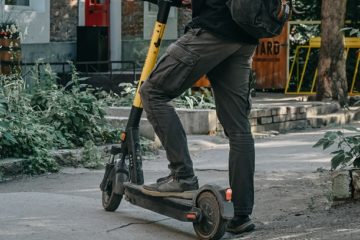Your electric scooter rides can quickly lose their fun when squeaking or slapping noises appear. This phenomenon is not an isolated case since most scooters encounter this problem one day or another. The good news is that there are effective, do-it-yourself solutions that will allow you to eliminate this unwanted noise. So, without waiting, discover what to do when your electric scooter squeaks?
Why does your electric scooter squeak?
Most electric scooters end up squeaking. Generally the extraneous noise appears at the level of the handlebars. But other elements of the machine can be affected such as the wheels, the wrists or the brakes. The squealing may come from the friction between mechanical components of the device, the deterioration or loss of lubrication components, a loosening nuts and/or screws, or finally, some loose parts over time.
In summary, the components of your electric scooter are deteriorating. This can happen due to several factors, combined or not, which will weaken the components and mechanisms of the scooter:
- repeated shocks or vibrations
- the condition of the roads or paths you take
- extreme temperatures
- your conduct
- natural wear
The squeaking or squealing of your electric scooter is therefore a symptom of a mechanical problem which may be mild or require repair to prevent premature wear of other components.
If your device is having charging issues, check out our article about it: electric scooter that no longer charges, what to do?
What can you do to get rid of the squeaking sound of your electric scooter?
For prevent your electric scooter from squeaking or squealing, many solutions exist. However, they will depend on the design and characteristics of your electric scooter. If in doubt, refer to the instructions for use of your scooter to be sure that the solutions proposed, and in particular the products used, do not damage your scooter.
Note: If your electric scooter is still under warranty (2 years from the manufacturer in France), we advise you to contact the after-sales service of the selling store or the manufacturer so that an approved technician can solve the problem. Note that if your repair results in breakage, customer service may reserve the right to void the warranty.
Lubricate the squeaky parts of the electric scooter
The first thing to do when your electric scooter squeaks is to lubricate the parts that cause this parasitic noise. For this, you can use silicone lubricant, the famous WD40 with PTFE designed to avoid friction. The PTFE formula leaves a dry film that provides better lubrication and better resistance to humidity. However, it will be necessary to reapply fairly regularly (about every 2/3 months) because the product eventually disappears. You can also use lithium grease, which provides longer-lasting lubrication. On the other hand, avoid oil which may run, attract dust and dirt and not hold up over time.
Using your product, lubricate folding axles and electric scooter mechanisms that squeak or rattle. You can lubricate the drive chain and wheels if the noise is coming from any of these parts of your scooter. Attention, the brakes do not grease. This could make the braking mechanism less effective and could therefore endanger your safety and that of other road users.
Generally, the part of the machine that produces the most squeaks is the gallows. Either the place at the level of the frame, between the handlebars and the footrest of the scooter. In this case, grease the inside and outside of the mechanism. Activate the mechanism to evenly distribute the product throughout. You can also use a toothbrush to grease all the elements well. Be careful not to put too much product. Apply sparingly, and adjust the amount as needed. Note that usually a small amount is enough. If the squealing noise persists on your electric scooter, then other solutions may solve the problem.
Grinding noise from the wheels of the electric scooter
If you find that the squealing noise from your electric scooter comes from the wheels, they may be in bad condition. Check first that they are well inflated (neither too much nor not enough). Then clean the bearings with a slightly damp cloth to remove dirt and debris that may have lodged there. Once clean, then add WD40 PTFE to avoid metallic friction which can cause these snaps or squeaks. Also remember to check that the screws have not loosened (a quarter turn is often enough to tighten them). If you notice that components are rubbing together or that they are too damaged, you will probably need to replace them.
Tighten the screws of the scooter
By dint of repeated shocks and vibrations, the screws can end up moving and loosening. The various elements of the scooter will then take some play, which will lead to abnormal mechanical friction and your scooter will then start to squeak.
To solve squeaking and play problems on your electric scooter, start by checking that the various screws on your scooter are tight. Generally, a quarter turn of the key is enough to tighten them well. Be careful, do not force either, otherwise you risk damaging or breaking the screws or the mechanism. Again, you can use WD40 to lightly lubricate the screws. The screws most likely to have moved are the wheels, stem and frame.
If the screws appear damaged, you can also replace them. Indeed, generally the original screws of scooters are of average quality. You can then replace them with stronger stainless steel screws. They will then tend to move less.
Adjust the lock of the electric scooter
Le lock is located inside the folding system of the electric scooter (at the level of the stem). This hook-shaped piece locks the machine's folding system. The adjustment of its position is done with the two nuts which are located inside. And very often, it is at this part that the squeaking appears on your electric scooter. This is explained because as you use and vibrate, this mechanism becomes disrupted and eventually becomes loose.
To eliminate the squeaking or clicking noise on your electric scooter, you can then try to tighten or loosen delicately one by one the two nuts which are used to maintain the lock and therefore which are located inside the folding system. For this, you will certainly need to use a combination spanner (depending on the scooter, the size of the spanner may differ but generally you will need a spanner of 8 and/or a spanner of 10). You will probably need to experiment with several combinations of tightening and loosening to find the one that keeps your scooter from squeaking. The goal is for the system to be firmly fixed, but for you to still be able to open and close the lock without forcing it.
Warning: closing the lock must be done with one hand, without forcing it. If you need to force, you will have to loosen the nuts because, in addition to risking breaking the lock, this can cause stress on the mechanism which can then end up giving up. If you are on the handlebars at this time, then it can be very dangerous.
You can also take the opportunity to add WD40 or lithium grease to the mechanism to permanently eliminate the squeaking noise on your electric scooter.
Reduce device handlebar play
Si your electric scooter still squeaks, there may still be some play in the stem and the metal may therefore rub against another metal part, creating squeaks, squeaks or rattles.

To avoid this, there are rubber vibration dampers. In addition to adding a small thickness to fill the gap, the metal will rub against the rubber which will of course attenuate the parasitic noises. There are different sizes of rubber shock absorbers (often 0,4 mm, 0,6 mm and 0,8 mm), which allows adaptation to the curve of the stem of your scooter model. You can easily find them on online merchant sites.
However, be careful. If when you put it on, you notice that the opening and closing system forces too much, this means that the size is not suitable. In this case, you will then have to slightly re-cut the rubber in the central notch to create space and that the various elements of the stem do not force too much. Then, proceed again to an adjustment of the nuts as seen previously. This is very important because, again, otherwise there is a risk of it breaking while you are riding. Finally, you can add WD40 PTFE if you haven't already.
What to do in case of persistent squeaking noise?
If your electric scooter continues to squeak or squeak, we recommend that you first consult online video tutorials specific to your model of scooter. You will certainly find information that is more targeted and specific to the characteristics of your machine. If nothing helps, we then advise you to call the manufacturer's after-sales service. It will also be able to provide you with more personalized information. Finally, you can also call on a professional repairer near you.



0 Comments